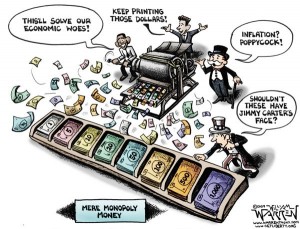 By Rick Manning
By Rick Manning
The federal government released the good news that revenue collections have reached an all-time high with total receipts of $1.935 trillion from October 1, 2013 to the end of May. The federal government projects that total federal government revenues for the entire year will reach just slightly more than $3 trillion.
Yet, even with this unprecedented flow of cash into the nation’s Treasury, the October-May deficit is an astounding $436 billion with May’s deficit alone totaling almost $130 billion.
The problem is that the record revenue flows are largely driven by growth inhibiting tax increases and the restoration of the payroll tax after a short-term stimulus cut. Yet, rather than holding the spending line so revenues could catch up with spending, the federal government is projected to spend $3.65 trillion for the year, more than ever in history.
In fact, federal spending in this fiscal year is jumping by almost $200 billion according to Treasury Department projections.
| Year | Receipts | Outlays | Surplus or Deficit (-) |
| 2009 | 2,104,989 | 3,517,677 | -1,412,688 |
| 2010 | 2,162,706 | 3,457,079 | -1,294,373 |
| 2011 | 2,303,466 | 3,603,059 | -1,299,593 |
| 2012 | 2,450,164 | 3,537,127 | -1,086,963 |
| 2013 | 2,775,103 | 3,454,605 | -679,502 |
| 2014 estimate | 3,001,721 | 3,650,526 | -648,805 |
| 2015 estimate | 3,337,425 | 3,900,989 | -563,564 |
| 2016 estimate | 3,567,952 | 4,099,078 | -531,126 |
| 2017 estimate | 3,810,779 | 4,268,606 | -457,827 |
| 2018 estimate | 4,029,856 | 4,443,145 | -413,289 |
| 2019 estimate | 4,226,119 | 4,728,791 | -502,672 |
With almost two/thirds of all federal government spending on automatic pilot, the above chart shows the mushrooming growth of outlays even with receipts projected to double from 2009 to 2019.
If the projected increase in federal government expenditures only rise by 2 percent over the next two years rather than the current 9.3 percent rise, and the receipts remained as projected, the deficit would be reduced to $256 billion in just those two years. Incredibly, this two percent increase in federal government spending over the next two years would lower the increase in the national debt by more than half a trillion dollars over that time.
Of course, capping spending growth will require tough choices by Congress on the large social welfare portion of the budget that automatically increases without a vote. These changes would be tough with reforms and policy choices needed to stop their projected runaway growth. However, failure to make even minor changes that slow their growth, consign our country to an additional $3.1 trillion in indebtedness before the end of the decade.
The United States is projected to get a revenue windfall over the next six years. There simply is no excuse to resume a spending splurge in celebration of these increases. Every person who has done their own family’s finances knows that when you have extra money coming in, the prudent thing is to put some of it away for a rainy day rather than just go out and get the biggest big screen television that will fit into your home.
It would be irresponsible for the federal government to, as projected, consume virtually every new dollar it receives rather than proceeding toward balancing the budget by 2020 through capping the growth of government.
On paper it is a simple math problem, the only question is will Congress have the political will so solve it.
Rick Manning is the vice president of public policy and communications for Americans for Limited Government.






